
The Ultimate Guide to Homeschool Education Methods
Starting the process of homeschooling can be scary! Whether you are excited or reluctant to get started the reality is having the responsibility of educating your own children can be a frightful prospect. But, knowledge is power. Having an understanding of different education methods can help you in choosing an education method that works best for your family.
There are several educational methods which are common to homeschool, then there are some you may not be familiar with. That’s why I want to share with you an ultimate guide for homeschool methods of education, so that, you can see in one place what method(s) might work best for you.
Each family should make a decision about a method by considering their own educational philosophy, the learning styles of their children or by the circumstances which dictate the way your homeschool and class schedule can be structured.
One thing to be sure of is that in homeschool, there is no right way or wrong way. As parents our goal should be to inspire our children to want to learn and provide the right circumstances by which they are able to do so.
Whatever way works best for you and your family is the right way for you. The methods can simply be a model or it can be the plan which guides your role as an educator. Listed below you will find some of the most well-known methods and perhaps a few lesser known educational methods. You may find the one method you have been seeking but haven’t quite grasped.
Or, you may find that you feel you are compatible with multiple methods. Then again, you may find that none of these truly represents your educational philosophy and that is o.k. too.
Making Sense of the Education Methods to Find Your Best Fit
Be sure to also read Learning Styles You Should Understand.
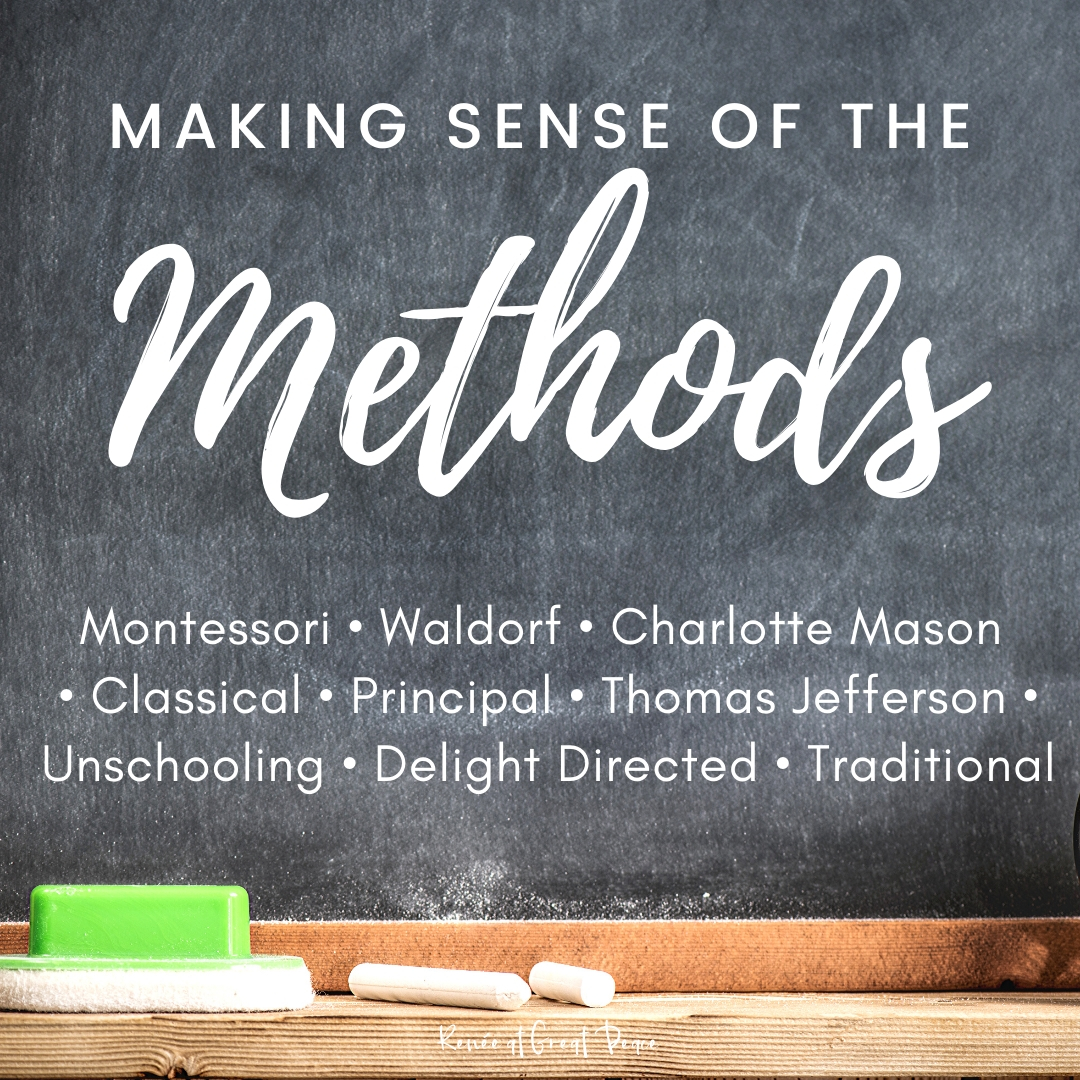
Guide to Homeschool Education Methods
- Traditional
This approach is found in most public and many private schools today. This method uses traditional text and workbooks. A homeschooling parent that purchases materials that incorporate this method, generally speaking, will find that lesson plans are formulated by professional educators and are included in the materials. Parent teachers can simply follow the lesson plans to instruct students at home. It is ideal for parents who want to see a lot of structure with lessons that are guided by professionals for classroom development.
Curriculum options for this method.
“Let us think of education as the means of developing our greatest abilities, because in each of us there is a private hope and dream which, fulfilled, can be translated into benefit for everyone and greater strength for our nation.” — John F. Kennedy


- Classical
Classical or the Trivium method is an approach born in ancient Greece and Rome and found its way to Western Europe and eventually America by the 16th century. This is the approach that was used to teach most of the founding fathers of America. Many private schools and homeschools are using this approach because of its simple and natural learning structure.
Generally speaking, the child learns through exposure to a wide array of ideas, from the earliest stages of life. It is based on the Trivium method which shows that students go through 3 stages of learning, the Grammar, Logic, and Rhetoric stages. The Grammar Stage being the memorization of facts, the Logic Stage being the age of argument to test those facts and the Rhetoric Stage for critical thinking and defense of knowledge.
Many Christian homeschooling families believe that this approach is also found as a Biblical model of education and therefore have adapted it to their homeschools. I suggest if you are considering the Classical approach that you read Teaching the Trivium by the Bluedorns. In fact, it is the first homeschool related book that I ever read.
Curriculum and resources which would be beneficial for this method:
- Classical Conversations
- Classical Copywork
- SQUILT-Music Appreciation
- The Well Trained Mind
- Trivium Pursuit
“An eternal question about children is, how should we educate them? Politicians and educators consider more school days in a year, more science and math, the use of computers and other technology in the classroom, more exams and tests, more certification for teachers, and less money for art. All of these responses come from the place where we want to make the child into the best adult possible, not in the ancient Greek sense of virtuous and wise, but in the sense of one who is an efficient part of the machinery of society. But on all these counts, soul is neglected.” — Thomas Moore

- Charlotte Mason
Charlotte Mason was an educator from the late 1800’s to the early 1900’s She believed that education centered around 3 areas of learning; atmosphere, discipline and life. Her approach to education centered around reading using living books, narration, dictation, copywork, and utilizing short lessons with great content.
This method incorporates core educational subjects with a strong emphasis on the humanities: classic literature, art, classical music, and poetry. The central theme of this method is that lessons are presented in “living books” which are made up of classic literature containing lessons surrounding the core subjects.
Curriculum and resources which would be beneficial for this method:
- Ambleside Online
- Charlotte Mason in 18 Simple Lessons
- Diana Waring Presents
- Shining Dawn Books, NaturExplorers, Living Math and Literature, Grammar Packets
- Simply Charlotte Mason
- Simply Charlotte Mason Seminar Pack
- Sonlight
- GeoMatters
“Self-education is the only possible education; the rest is mere veneer laid on the surface of a child’s nature.” — Charlotte Mason

- Delight Directed
Delight directed learning takes into account the individual needs, learning styles and interests of each child in the family. The teacher works to gather resources for each child which will inspire them to learn. Using those resources as well as core subject curriculum the teacher structures the child’s day and lesson plans. This method incorporates specific core requirements and covers all subjects.
Often delight directed learning is used in conjunction with another method or approach. It is giving the child a measure of freedom to learn what they want in a way which will be of greatest benefit to them by utilizing their learning style and life interests. While delight learning is allows for inspired learning it does not focus solely on the delights of the child but is more of an asset to the full scope of an education structure.
There are no specific curriculum options for this method.
“Thank goodness I was never sent to school; it would have worn off some of the originality.” — Beatrix Potter

- Eclectic
The Eclectic Method is a method which incorporates 2 or more other methods to encompass multiple approaches to learning into one cohesive form. This is not just a haphazard approach to education. Rather, it is the choosing one’s own philosophy of education based upon established methods. One might agree with a portion of one philosophy while understanding that what works for one child, may not work for another.
The Eclectic Method brings together styles and philosophies in a way that is unique to the teacher and student. This allows for a truly customized education to meet a child’s needs.
The eclectic homeschool might use traditional text books for some subjects of learning while pulling together unit studies for others. One might like the philosophy behind a particular method, like Classical, but find that their student approaches learning better in a Charlotte Mason environment. Therefore that parent might incorporate a lot of reading into their day while being mindful of the philosophy that she wants to use to guide her child.
Homeschooling affords flexibility at its best. An eclectic approach means simply determining what areas you want to teach then choosing a method for each of those areas that the teacher feels best fits her teaching style or the learning style of her student. The Eclectic Method may work best for teachers who are able to easily adapt and change course to suit the need. This approach requires one to be flexible and open to thinking outside the box. The parent/teacher has specific educational goals in mind and makes deliberate and purposeful choices to meet those goals. Students who need to explore at their own pace and interest might thrive in an eclectic learning environment.
Curriculum options for this method:
“Education is not filling a bucket, but lighting a fire.” — William Butler Yeats

- Thomas Jefferson Education, TJed
This educational philosophy was written by Oliver and Rachel DeMille. It is based upon seven principles of education and allows for delight led learning. The seven principles are incorporated over the educational life of the child through 4 phases. The four phases are the core phase from ages 0-8, the loving learning phase from 8-12, the scholarly phase from 12-16, the depth phase from 16-22. Following the last stage each individual sets out to application phase of impact and application where they fulfill their life roles and missions.
This is more of an educational philosophy than a method but it is gaining in popularity among homeschoolers. It is grounded in a classical reading program and seeks to reflect an education that guides students to become leaders.
The education is based on seven keys to success:
- Classics, Not Textbooks
- Mentors, Not Professors
- Inspire, Not RequireStructure Time, Not Content
- Simplicity, Not Complexity
- Quality, Not Conformity
- You, Not Them
There is no specific curriculum for this method, and other than a classical literature reading the curriculum is left to the parent and any curriculum can be adapted to the philosophy. It is suggested that the following book be read in order to understand the philosophy surrouding TJed: A Thomas Jefferson Education.
“An honest heart being the first blessing, a knowing head is the second.” — Thomas Jefferson

- Montessori
Dr. Maria Montessori (1870- 1952) was an Italian educator who believed that for children, play is work. They learn best when presented with real life scenarios and have an opportunity to work through their challenges at their own pace which, helps them to build skill levels.
The Montessori method is a multi-aged, child-centered and self-directed method which places developmental challenges within a child’s learning scope. The teacher creates the learning environment while the child through individual choice makes work with what is presented within the environment. The teacher observes the child and determines when they are ready for additional challenges and subsequently places those challenges in their path. It is up to the child whether to select the challenge.
The Montessori Method is based upon her philosophy that there are 4 planes of learning. Plane One, the birth to about age 5 stage, contains 3 subsets of concepts, the Absorbent, Sensitive and Normalization periods. Plane 2 covers from about age 6 to 12 years of age and shows the child to be at the stage where the work of the child is to form intellectual independence, morality and social development. Plane 3 is the adolescent stage and the work of the child is to form and determine their own self in relation to society. Plane 4 is an early adult stage regarding the beginning of independence as an adult in society.
The Montessori Method may be best for children who are independent minded as well as those who are kinesthetic (physical) learners. This approach encompasses language development and hands on math through sensory processing as well as daily life practical learning.
Curriculum options for this method:
Montessori schools operate under the umbrella of the International Montessori Foundation. Yet the method can be adapted with materials you have at home or which can be found in many educational supply stores. That being said, here is a listing of resources for your benefit.
- Affordable Montessori Materials– Canadian & North American Supplier
- American Montessori Society – From their “Starting a School” section you can find downloads detailing materials needed and their scope in which a child is expected to attain mastery of a skill.
- Neinhuis Montessori, for classroom materials, the original developer who worked with Dr. Montessori to create these wonderful products.
- The Montessori Foundation, A great resource for learning more information about the Montessori method.
“Our care of the child should be governed, not by the desire to make him learn things but by the endeavor always to keep burning within him that light which is called intelligence.” — Maria Montessori

- The Principle Approach
This approach to education is based upon an American Christian History and Government philosophy. The approach is grounded in a Biblical Christian worldview and the historical documentation that the American government was founded upon the same worldview. The Principal Approach models two philosophies of education, one being the Hebraic philosophy that places the teacher in the role of mentor and the other is the Colonial American Christian Heritage in which Christ and Biblical form of government are taught in every subject.
The Principle approach places the teacher as the mentor of the child and acknowledges that the parent is given this mandate within the Biblical model for education. The teacher is expected to be a living example for the student to model. This method holds the student accountable for their learning while at the same time valuing the dignity of the child so that they can develop to their fullest potential in Christ.
This educational method focuses on the Bible and its teaching in all instruction, applies the principles of Biblical reasoning, Christian character formation and self-discipline as self-governing. It uses the 1828 Noah Webster dictionary as a basis for vocabulary understanding of liberty which stems from a Biblical worldview. This approach incorporates seven principles into the method with each principle building upon the other.
- God’s Principle of Individuality
- The Principle of Christian Self Governing
- The Principle of Christian Character
- Conscience is the Most Sacred Property
- The Christian Form of Our Government
- Planting the Seed of Local Government
- American Political Union
Curriculum options for this method:
“There is but one straight course, and that is to seek truth and pursue it steadily.” –George Washington

- Unit Studies
Unit Studies pull all subjects of learning together in one unit. A unit study focuses on one central theme while incorporating as many areas of learning as possible. Unit Studies are often found in other methods of education, specifically Charlotte Mason, Montessori, and Waldorf. Such units can be adapted to any style of learning as well.
For example a unit study about apples might include literature related to apples, vocabulary words related to apples, history related to apples such as the history of Johnny Appleseed, and science about how apples seeds are spread, germinate, plant growth, apple growth and then the redistribution of seeds. The lessons could even be expanded to study soil and water, farming, industry and even economy.
Often teachers who adopt the unit study method will use either, notebooking, lapbooks, or both to document what the child is learning.
With unit studies the direction and depth of scope are both at the teacher’s discretion. You may find that your student becomes so interested in the unit that they, of their own choosing, continue their research and learning even when school is not in session.
The Unit Study method may best be suited for students who are kinesthetic learners, those who like to be hands on in their learning style. Children who also learn in small amounts might also do well with this approach since they document small bits of information at a time.
Curriculum Options for this method:
- A Journey Through Learning
- Currclick
- Homeschool Share, a free unit study and lapbook resources page.
- The Notebooking Fairy
- Susan Evans eStore
- Unit Studies by Amanda Bennett
- The Weaver Curriculum
“Tell me and I forget, teach me and I may remember, involve me and I learn.” — Benjamin Franklin

- Unschooling
Unschooling is a method that allows for natural learning. Similar to delight directed learning, this method seeks to allow children the opportunity to learn in their own way and at their own pace. The biggest difference though, is that unschooling does not follow any structure but rather lets the child determine their own ath to learning. The goal of this approach is to let a child seek their knowledge in a natural progression from birth through life. The philosophy is that the child by their nature of curiosity will seek answers to questions, explore their world for understanding and obtain knowledge through experience.
This approach does not mean that parents cannot teach to their children or that children must only learn on their own. Parents remain active in the lives, education and development of their children. They do this by seeking their interests and the interests of their children and filling their life with experiences that reflect those interests. In doing so, the children are exposed to real life learning.
The family that is suited for the unschooling approach to education is one that is seeking to provide an organic learning style. They want to provide opportunities to experience life through the arts, books, museums, travel, nature and daily life. There really is no limit to the depth of learning that can be explored in this way.
There are no specific curriculum options for this method.
“The secret of education lies in respecting the pupil. It is not for you to choose what he shall know, what he shall do. It is chosen and foreordained and he only holds the key to his own secret.” — Ralph Waldo Emerson

- Waldorf Method
Developed by Rudolf Steiner in 1919, this method emphasizes the arts while teaching the students through a spiral approach to learning. A student of the Waldorf method may study one subject in depth over a long period of weeks. The scope of the curriculum covers all area sof basic subjects in order to give a basic knowledge of experiences by which to choose what is of interest to the child themselves.
The Waldorf Method also encompasses 3 stages of learning. These are identified as; Imitation, Imagination, as well as, Discrimination and Judgment. Each stage encompasses 7 years of life.
This method may be ideally suited for children who show artistic tendencies in art, music, dance, crafts or other artistic mediums.
Curriculum options for this method:
“Receive the children in reverence, educate them in love, and send them forth in freedom”– Rudolf Steiner

Be sure to read; 10 Homeschooling Words You Need to Understand.
Homeschool Education Terms to Know
~ DeSchooling
This is not a method of education, but I feel it is important to note this term here. If you are leaving a public school setting and entering the homeschool environment for the first time you may hear the word “deschooling.” This is not to be confused with an “unschooling” method. Deschooling is a brief period of time, taken following a public or private school enrollment to allow children the opportunity to decompress from institutional learning. It gives them a chance to be kids without pressure and to rediscover their own desire for learning.
At the same time this gives parents a period of time to research, consider, pray and choose an approach to establishing their homeschool. Many parents rush out to buy curriculum only to find themselves frustrated because their homeschool doesn’t function the way they thought it should. Too often, parents want their homeschool to be a slight reflection of their former institutional school, yet the reality is a home and family environment does not function that way.
During this period no formal instruction is given. This time period may last several weeks or several months. Whatever the length of time for the break, know that the goal is to prepare heart, mind, and attitude toward a different approach to learning and a long term goal for life education.
~Notebooking
Notebooking can be done in a variety of ways but generally a child documents their work by writing, drawing or pasting into a notebook. It can be incorporated into a variety of methods and can simply be a tool in the homeschool teachers toolbox.
Best Resource for Notebooking: The Notebooking Fairy
~Lapbooking
A lapbook is generally made of a file folder that is folded in thirds then the student adds in mini-books which are made of folded paper. On each of the mini-books the student presents areas of knowledge they have learned in their study. Lapbooking can be utilized by any method.
Best Resource for Lapbooking: Homeschool Share
“Self-education is, I firmly believe, the only kind of education there is.” — Isaac Asimov

I think it’s important to consider both method and learning styles when choosing a path for your children. So I am linking to a listing of student learning styles. Knowing how our children learn can help us to determine the method which will foster that learning style. I truly believe that you can’t have one without the other.
Did you discover any new methods? Which one(s) speaks to you homeschool mom heart?
You will find more Ultimate Guides for Homeschool and Resources for Homeschool Moms at the iHomeschool Network’s link ups.





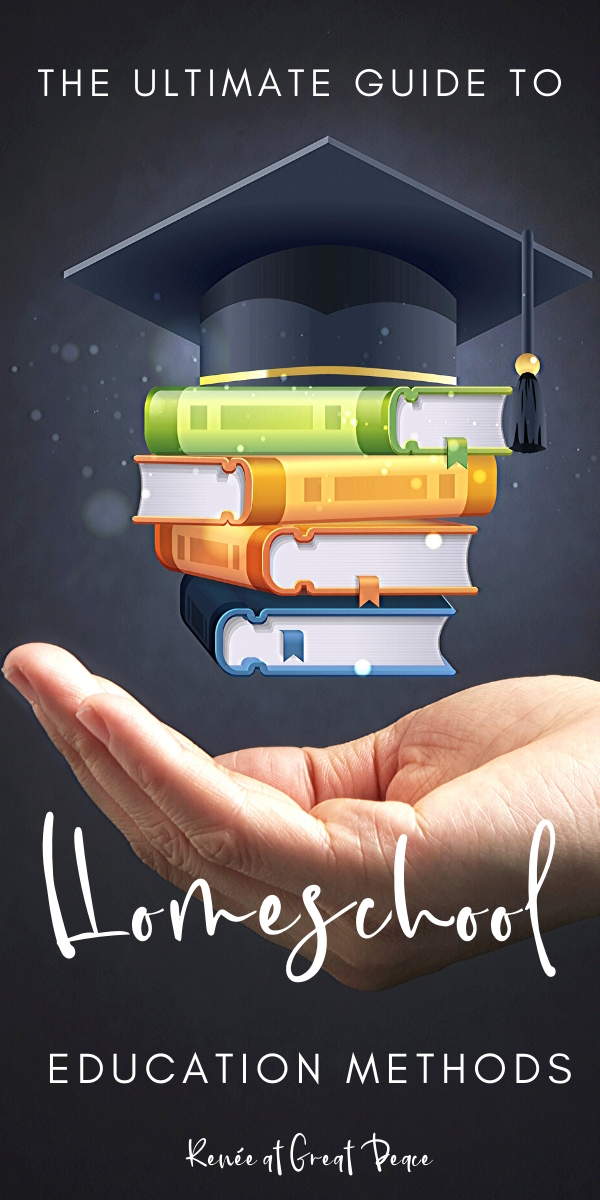
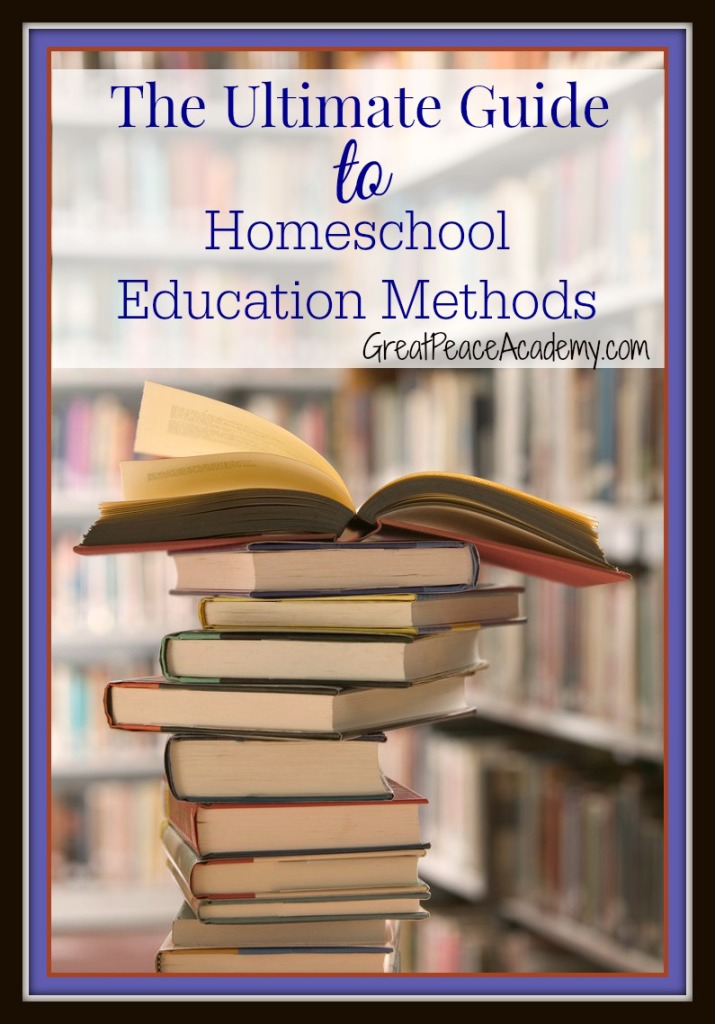
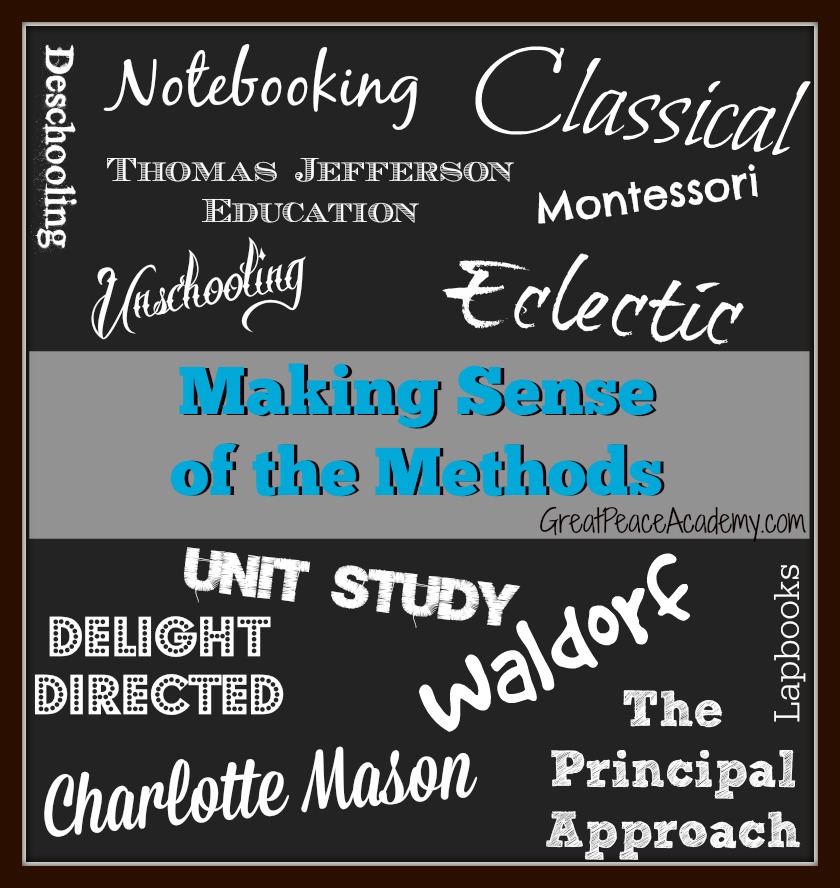


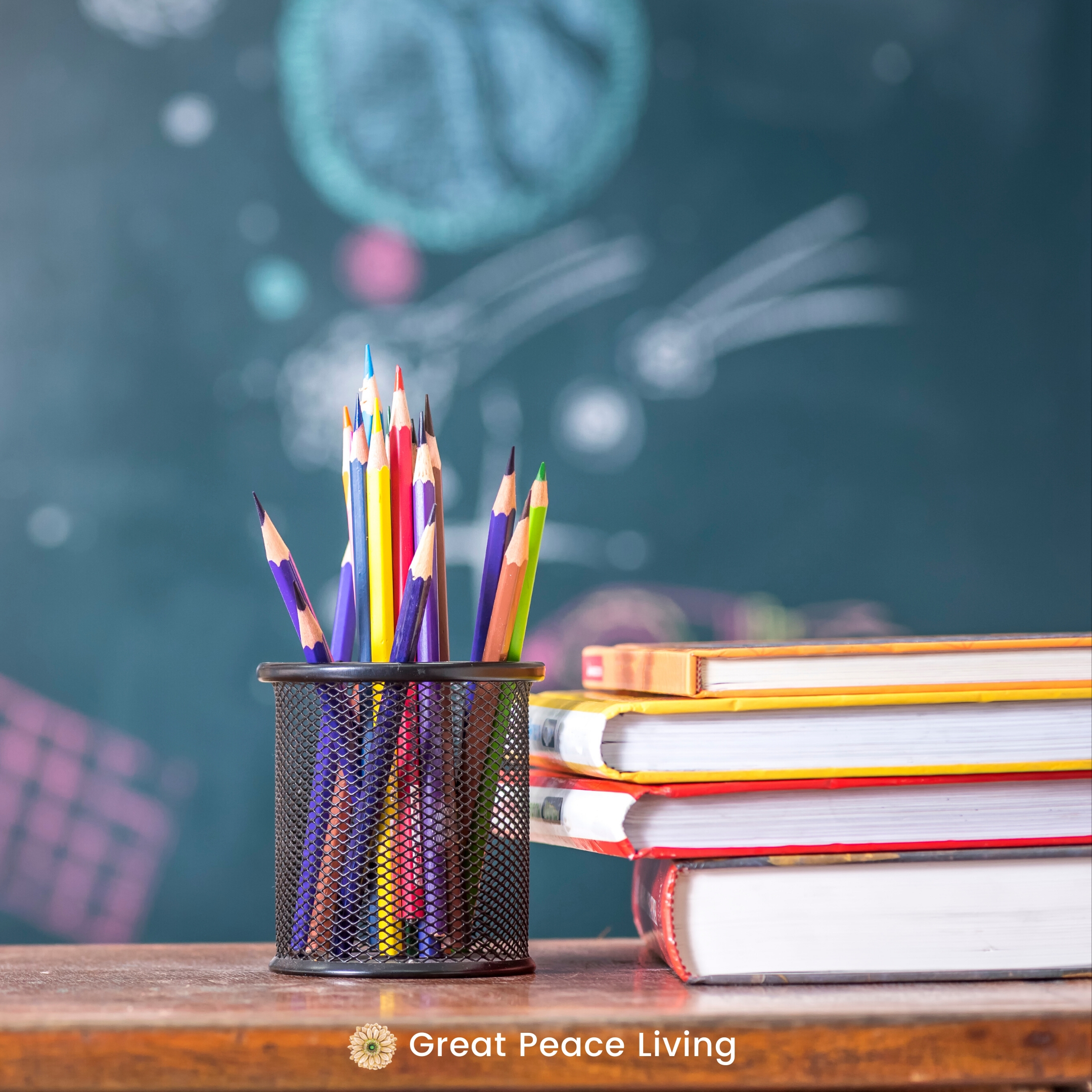
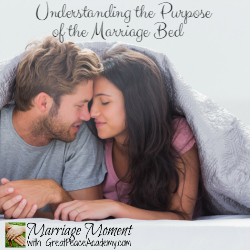
17 Comments
Becky
I love this! Thanks for sharing all the info and sources. I have used Amblesideonline for over 8 years and have loved it. Another good one is http://kindredlearning.com/ Theirs is based on a 4 year plan and is Christian based. Thanks again for opening my eyes to a few new ones.
Renee Aleshire Brown
You are welcome. Which method would you feel Kindred Learning most closely reflects?
LuAnn Braley
This is probably the best side-by-side comparison of methods I have ever seen. Excellent job!
Renee Aleshire Brown
Thank you LuAnn, I really tried to be thorough and make the language simple enough to understand.
SonjaB
All in all, a good comparison and cheat sheet of methods, although a few mistakes in the Montessori explanation. There are several resources for traditional Montessori curricula (albums), but you are right in saying you don’t need it to follow the philosophy. You should have also referenced the books authored by Dr Montessori for further explanation, and/or some modern works by international Montessorians.
Renee Aleshire Brown
I’d love to know where I made mistakes in the Montessori explanation.
Carrie
Thank you for this. We still haven’t had our feet wet with homeschooling (my oldest is 4), but we’re leaning more towards a Charlotte Mason approach. Having this broken down is refreshing. The best part is that you listed the coordinating curriculum. When you’re first starting out and looking at all of your options, it can be quite overwhelming!
Renee Aleshire Brown
You are welcome. I’m sure there are other curricula companies that correspond with each but I tried to provide what I knew, found or just a good variety where available.
Janette Metz
I wish I would have read this before I started looking through all the possibilities, never the less, I am glad that I am reading it now! To me, this is a post everyone should read before homeschooling for the first time, like me!
Renee Aleshire Brown
I’m so glad you are finding this helpful to you. I think it’s improtant to know methods and learning styles of our children, I too wish I had found a ready resource such as this when I was starting out. That’s why I’m sharing it now. 🙂
Elisabeth@Treasuring the Moments
I also have used Ambleside Online for years and for the most part have been very pleased with their book selections.
I agree with you for the most part that what works for one may not work for another but I just have a hard time accepting that the traditional method is the best way for any family. We want to raise thinkers but yet rote memorization of facts does not promote understanding or lead a person to analyze the information.
Great Peace Academy
I agree traditional doesn’t work for most people/students. But I do know of some families who use a traditional approach. What works for one, may not work for others and vice versa. Nevertheless, it’s good to include it in such a listing so that others can compare.
Pingback:
Pingback:
Pingback:
Montessori World Map, Flags and a Stand
Thank you so much for sharing this guide with us, this will gonna help many parents and teachers to teach their Montessori kids or students respectively. Keep sharing more helpful post like this.
Pingback: